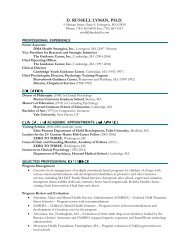Commonwealth of Massachusetts - DMA Health Strategies
Commonwealth of Massachusetts - DMA Health Strategies
Commonwealth of Massachusetts - DMA Health Strategies
- No tags were found...
Create successful ePaper yourself
Turn your PDF publications into a flip-book with our unique Google optimized e-Paper software.
or drug incidents. 10 Individuals who are identified as having misuse, abuse or dependence can be encouragedto get specialty treatment. Although treatment is known to be effective, 11 a significant proportion <strong>of</strong> all thosewho need addiction services still do not receive them. 12 It is vital that people who need treatment have easyand rapid access to services when they are screened and that transitions between services and levels <strong>of</strong> careare smooth and effective.Strategy 1: Integrate substance use and addictions screening, services and skills into health caresettings, including primary care, emergency departments, federally qualified health centers andmedical homes.Implementation Team Leader: SBIRT Coordinator, BSAS• Support health and mental health care settings in sustaining and expanding the use <strong>of</strong> SBIRT.• Encourage use <strong>of</strong> SBIRT as standard operating procedure in schools and colleges.• Expand the use <strong>of</strong> the CRAFFT screening tool for youth.• Encourage standard and routine screening in criminal justice settings.• Use screening results to provide brief interventions for those using substances in a risky or unhealthymanner and to link to treatment individuals in whom substance use and addictions or dependence isindicated.Strategy 2: Increase availability <strong>of</strong> information on substance use and addictions, self-care andtreatment options for all stakeholders.Implementation Team Leader: Assistant Director, Quality Assurance & Licensing• Enhance and simplify the BSAS website and encourage its use as a key resource that supports accessto services and <strong>of</strong>fers “how to” strategies.• Advertise the Substance Abuse Information and Education Helpline.• Encourage the use <strong>of</strong> peer and parent support services where appropriate throughout the servicesystem.• Develop an on-line information portal for youth and parents that will increase public awareness <strong>of</strong>prevention resources, central intake and services for youth.• Help all consumers understand their rights, including their rights to appeal denials or other serviceproblems.• Provide mechanisms to support communication, networking, technical assistance and qualityassurance for providers <strong>of</strong> new services, as has been done for Office-Based Opioid Treatment.10 Babor, T.F. and Higgins, J.C. 2001, Brief Intervention for Hazardous and Harmful Drinking: A Manual for Use in Primary Care.World <strong>Health</strong> Organization, Department <strong>of</strong> Mental <strong>Health</strong> and Substance Dependence; L.I. Solberg, M.V. Maciosek,, N. M. Edwards,“Primary Care Intervention to Reduce Alcohol Misuse: Ranking Its <strong>Health</strong> Impact and Cost Effectiveness,” Am J Prev Med2008;34(2):143–152).11 Simpson, D., et al. “Overview <strong>of</strong> National Treatment Outcome Studies,” http://www.datos.org/.12 Whitter, M. “Recovery in the Community: An Emerging Framework – A Recovery oriented Systems Approach,” NASADADAnnual Meeting, June 6, 2008. http://pfr.samhsa.gov/docs/NASADAD_ROSCs_presentation_0608.pdf.Substance Abuse Strategic Plan Update Page 16July 2010





